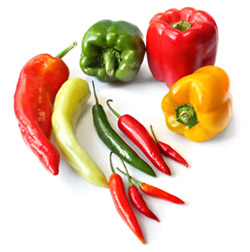Peppers come in a variety of colors, shapes, sizes and flavors ranging from sweet to spicy hot. They are a colorful addition to any meal, or they can be enjoyed as a snack on their own.
The bell pepper is the most common pepper in the United States. These sweet peppers are packed with nutrients like vitamin B6 and vitamin C, and they are a good source of dietary fiber. Bell peppers also contain more than 30 different disease-fighting phytochemicals called carotenoids, which give them their vibrant colors. Carotenoids such as beta-carotene have antioxidant and anti-inflammatory benefits.

Bell peppers come in a range of colors — red, orange, yellow, green and even purple — and some colors offer additional benefits. Yellow peppers have a slight advantage by containing more folate and iron. Yellow and red have twice the amount of vitamin C found in green peppers. The carotenoids in red and orange peppers provide more vitamin A, which is beneficial for our eyesight.
Each type of pepper has a unique color, shape and flavor. While some are mild, others may be extremely hot. Chili peppers are used primarily for seasoning foods. Banana peppers are shaped like a banana and are a mild pepper. Hungarian wax peppers may be confused with banana peppers, but they have a lot more bite. A simple taste test may be required, and selection should be based on the dish it is used in and personal preferences.
With the wide variety of peppers available, they are very versatile. Peppers can add flavor and color to many different dishes or they can stand on their own as a side dish or snack. To start, select peppers that are well-shaped, firm and glossy with taut, unwrinkled skin.
Store unwashed peppers in a plastic bag in the refrigerator for up to a week. If you notice any soft spots, use those peppers immediately. Green peppers tend to keep longer than red peppers.
Peppers are great broiled, grilled or fire-roasted. Slice the peppers into flat panels and remove the stem and ribs. Place skin up if broiling or down if grilling. When skin starts to blacken 6-10 minutes, remove from heat, place in a bowl and let them set for 15 minutes. This loosens the skin so that it peels off easily. Fire-roasted peppers are left whole and the skin can be removed after the cooking and set time is completed.
Peppers also freeze well and do not need to be blanched. Thawed peppers are best for casseroles and other cooked dishes; some crispness may remain, though, so they could still be used in salads or eaten as a frozen snack.
Fresh raw peppers are great for eating with a low-fat dip, or they make a tasty, crunchy addition to salads and other cold dishes.
Whether small or large, red or green, sweet or spicy, peppers are a great vegetable to add to your table this summer.
--Holly Jay, former nutrition and health education specialist, Cass County, University of Missouri Extension
References
UC Berkeley (2002). Wellness Foods A to Z. NY: Rebus, Inc.
Lori Zanteson (June 2016). "Bring in the Bell Peppers!," Environmental Nutrition Newsletter